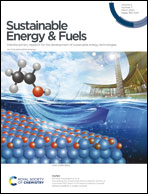An environmentally friendly natural polymer as a universal interfacial modifier for fullerene and non-fullerene polymer solar cells
Abstract
Green fabrication, including green materials and green solvents, is an attractive technique in organic electronics. In particular, the application of green materials is an emerging issue for polymer solar cells (PSCs). In this study, an environmentally friendly natural polymer derivative of hydroxypropyl cellulose (HPC) is utilized successfully as an efficient cathode interfacial modifier in PSCs. The HPC shows universal properties as an interfacial modifier both in fullerene and non-fullerene PSCs. By introducing HPC as the cathode interfacial layer (CIL), the photovoltaic performance was improved dramatically than in devices without HPC CILs. Compared to bare cathodes, the PSCs with HPC as the CIL afforded higher open circuit voltages (VOCs) and fill factors (FFs) because HPC forms a better, denser, and more uniform high-quality film on the active layer, as demonstrated by atomic force microscopy (AFM) and water contact angle (WCA) measurements. In addition, the existence of polar hydroxypropyl groups in HPC creates good contact between the active layer and metal cathodes to efficiently decrease the work functions of the cathodes, leading to lower geminate recombination and higher charge mobility than those of cathodes without CILs both in fullerene and non-fullerene systems. These findings indicate that the natural polymer HPC is a promising candidate as a CIL both for highly efficient fullerene and non-fullerene PSCs.



 Please wait while we load your content...
Please wait while we load your content...